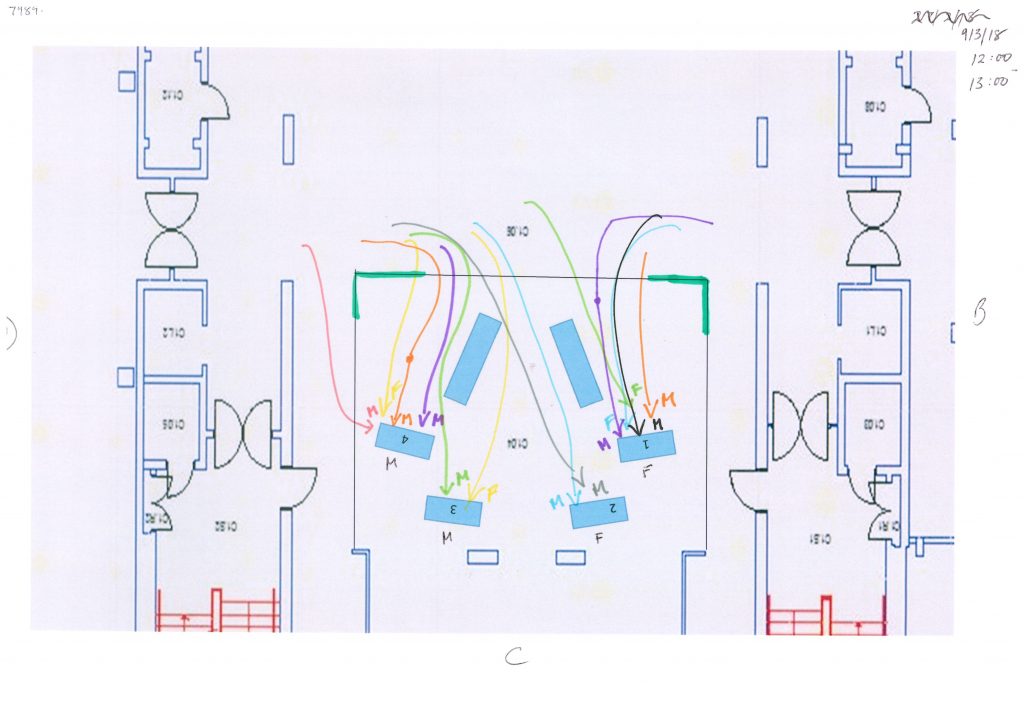The Support and Liaison team are keen to see whether the current set up of the IT & Library Support Desk area in Block C, Floor 1 in the Templeman Library maximises user engagement. To this end, we decided to organise some behaviour mapping which is a type of systematic observation research that tracks behaviour over space and time with the following objectives in mind:
- observe user interaction with support desk staff
- see which desks are busier
- see whether we can make any improvements
We also wanted to see how the users interacted with the space:
- what do they see
- how do they move through the space
- what do they ignore
- what paths do they take?
We wanted to gather this information in order to help us make changes to the layout of our desks to improve the user experience.
Observations
The behaviour mapping exercise took place at the end of February / beginning of March 2018. Observations focused on user behaviour, in particular:
- Support Desk staff – whether they were male / female
- users – whether they were male / female
- direction of entry of user
- trajectory towards staff member on desk
- whether user stands and pauses before approaching desk
- whether moveable seating has an impact on user

- We printed off identical floor plans of the Support Desk area and manually recorded the journey of visitors arriving at the support desks using different coloured pens to distinguish between different visitors.
- The four front desks were labelled numbers 1 – 4.
- The partitions at either side of the Support Desk area were marked in pen on the floor plan.
- We recorded the gender of the support desk staff and the gender of the visitors (see diagram 1 – M (Male) F (Female)).
- Observations were taken by the same person at different times of day (morning, afternoon, evenings and weekends) for an hour at a time during a three week period.
- Specific timings of individual visitors were not recorded.
- Observations were mainly taken from the second line support desks and to maintain the integrity of the exercise, staff and customers were not advised of our mapping activity in advance.
What did we find out?
The results showed that Desk 1 had the most visits and Desk 3 the least visits. This could be because Desk 1 is nearest the stairs that lead directly upstairs from the Welcome Hall and it is also the side that the café on the ground floor is on.
Before starting these observations, the soft seating had been moved into a V shape in the middle of the support area (reflected on Diagram 1). Results showed that the placing of the seating seemed to funnel visitors towards individual desks. Some users were hesitant before approaching a particular support desk, especially if there were several desks to choose from. 57% of visits were from male visitors and 43% were from female visitors. The gender of the customer did not seem to have any particular impact on the gender of support desk staff they approached.
We realised that there are limitations to this exercise as there are floor boxes which cannot be moved and therefore dictate to a large extent where the desks have to be located. But we did see that even small changes like rearranging the seating can make a big difference to the user experience. Overall though, this exercise demonstrated clearly that if staff are friendly and engaged, it draws users in whatever the starting point.
Next steps
We would like to:
- Move seating and repeat the exercise to see what impact this has on user behaviour
- Look at alternative forms of seating
- Consider planters to divide up the area and make it more attractive
We also want to bear in mind some useful advice from JISC (Joint Information Systems Committee) which outlines a very simple set of principles, ie that space should be:
- Flexible – to accommodate both current and evolving pedagogies
- Future proofed – to enable space to be re-allocated and reconfigured
- Bold – to look beyond tried and tested technologies and pedagogies
- Creative – to energise and inspire learners and tutors
- Supportive – to develop the potential of all learners
- Enterprising – to make each space capable of supporting different purposes
See also the UK Higher Education Learning Space Toolkit from UCISA.
